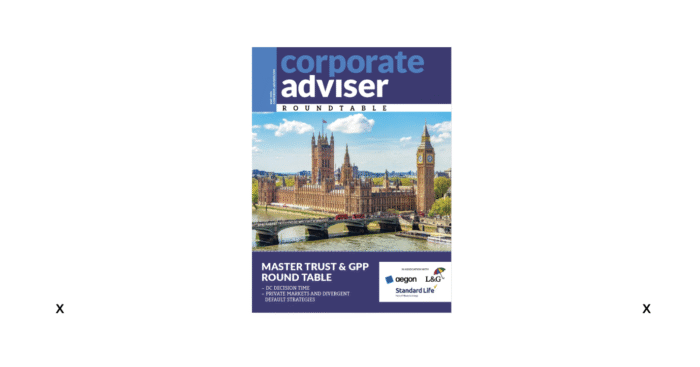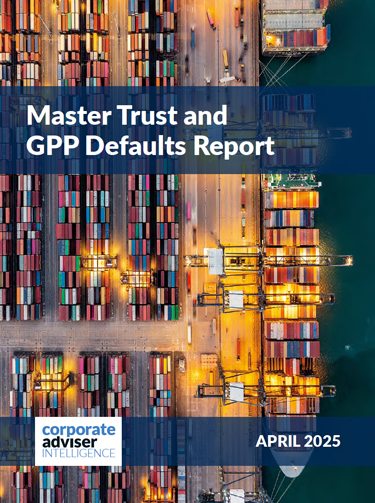The DC pensions sector stands at the cusp of significant change – with policymakers looking to introduce minimum size thresholds alongside new standards on value for money, better retirement support and more diversified investment strategies, particularly in relation to private market allocations.
TO DOWNLOAD A PDF OF THE ROUNDTABLE EVENT CLICK HERE
So how will this raft of regulatory change impact the adviser or employer decision-making process when it comes to selecting DC schemes? This was one of the key questions under debate at a recent roundtable event to discuss the findings of Corporate Adviser’s latest Master Trust and GPP Defaults report.
Consultants attending the event agreed these factors were an important part of the matrix when it comes to creating a shortlist of potential DC schemes.
Hymans Robertson head of DC markets Paul Waters said: “When it comes to decision making today, it is all about quality and fit.” Waters said there has been a significant improvement in the quality of DC pension propositions in recent years.
Johnson Fleming regional director Martin Parish agreed that the bar had been raised across the industry. Barnett Waddingham partner Paul Leandro added: “As a result, it is difficult to differentiate now between the main providers’ propositions,” – a view echoed by the other consultants in the room.
But distinctions have to be made, and the providers at the event were keen to hear what factors advisers prioritise when making a shortlist — and how employers ultimately decide which company will manage their employees’ pensions.
Redwood Employee Benefits Services managing director Jason Brice said: “Given the quality of these propositions, it means there is a stronger focus on service standards.”
Lift Financial, director of Lift-WorkWise Suzanne McGowan said this is where the ‘fit’ element comes into place, in relation to the particular corporate client. She said that with many doing the basics well, it is a case of looking at what additional services are available as part of the proposition. “Often it is a case of looking at all the bells and whistles on a scheme, particularly in relation to member experience.”
This chimed with what Capita’s director of pensions policy & propositions Anish Rav has observed. He said
employers were now more focused on their employees when considering provider options.
“Several years ago when we were doing selection exercises there was a focus on implementation and process, how the provider can help the employer, for example with onboarding. Now there is more focus on the employee, in terms of outcome and functionality.”
Portals and apps aimed at members are seen as an important part of an overall proposition, with Rav saying he has seen cases where the client will get individuals to test the various services being offered before making a final decision.
It isn’t just about functionality though. Rav says that “cultural fit” also drives decision-making at every level. “We know all shortlisted providers will do a good job. But for those making these decisions, it can be based on which company they think they will be able to work best with, or who’s going to be there when things go awry. As consultants and advisers we’ve got the hard facts on propositions, performance and charges to draw up a shortlist, but when we’re talking about fine margins, it is these sorts of subjective assessments that can be the real clincher.”
Willis Towers Watson director Gemma Burrows said this means that the final pitch from providers still has a key role to play. Those that don’t address clients’ specific needs are unlikely to win the business, she said. “We’ve had feedback from clients where a pitch team has turned up and delivered a generic pitch about their proposition. Sponsors are alert to this.”
Isio partner and head of DC pensions Richard Birkin agreed. “Pitches don’t have to be slick. It’s more important to ensure the people delivering it really know their subject, and demonstrably care about issues like member support and vulnerable customers. This is more important than the style of the presentation and can be a real differentiator for clients.”
However, consultants said they did not think that there was always enough emphasis on the at-retirement proposition offered by providers, both in terms of support services and investment options.
“People are putting nowhere near enough emphasis on the retirement experience at present,” said Waters. “This should be one of the key data points: what are members of a scheme doing with their money at retirement? I think employers are asleep at the wheel if they are not measuring up providers on this information.” He said there will be cases where people have small pots and are taking this as cash but added alarm bells should be ringing if a significant portion of the member base were moving money elsewhere at retirement.
Leandro agreed that this should be a key focus for employers, particularly those with ageing workforces. “Employers want their employees to be able to retire, and to retire with dignity, so more are likely to be asking how providers might support them with this.”
Investment v costs
Investment performance and cost still remain a key part of the decision-making process.
Leandro says: “When we’re talking about which providers to shortlist there is a focus on investment performance because the clients see that as the main driver towards accumulating wealth.” He says that other factors, such as increasing contribution rates, could lead to better outcomes, but this is “very difficult to change and get onto the board agenda”.
Investment performance is inherently backwards-looking, but consultants said this needs to be balanced against the changes currently being made to default funds, particularly in relation to including private market assets.
Those at the event agreed that more diversified portfolios had the potential to deliver better outcomes for members, even with higher charges – although it was noted that there was often an unwillingness from employers to pay higher costs at present, particularly when schemes operate a dual-default model.
But those at the event agreed that across the industry the debate was starting to move from ‘cost’ to ‘value’ – a shift welcomed by both consultants and providers as being an important way to boost longer-term outcomes. But consultants said it was inevitable that charges are still part of the conversation, although they were no longer the sole driving factor when it comes to scheme selection.
Waters said that at the end of this process, once the shortlist had been discussed, employers might ask consultants to negotiate with providers as to whether they could move on costs.
“I think the difficulty is that cost is a very tangible measure, when compared to ‘value’ which depends on unknown future outcomes,” said Burrows. “We shouldn’t forget that it is the employer that has to deliver the messaging to the employee when they are switching schemes, and messaging around issues like cost is really key for sponsors making this decision.”
Legal & General’s head of DC clients Jayesh Patel said: “It is clear some employers are still fixated on cost –
but there’s been a move in the advisory space towards value, and an acceptance that diversification should lead to better member outcomes; that is a good thing.”
Standard Life head of investment proposition distribution Callum Stewart said he would like to see regulation effectively removing the issue of costs from the decision-making process – at least at the initial stages. As he pointed out, costs might be tangible, but there is also now evidence that the inclusion of private markets should deliver better outcomes for members.
“The question is that if we are unshackling the cost constraint, what can we do with this? Costs might be certain today, but how certain do we need to be on future outcome potential? From our modelling over the longer term, we’re 90 per cent certain that adding a sizeable allocation to private assets will improve outcomes.”
Stewart says he would like to see a new framework for the provider selection process, focused on quality, service, customer experience and outcomes. “At that point, if you land on two providers that look the same when it comes to outcomes, experience etc, then absolutely go for the cheapest one to deliver on all these metrics. But the critical difference is you are not letting cost influence the outcome.”
He said he’d like to see consultants regulated to improve this selection process and remove employers over-ruling their recommendations. But Parish said he was not aware of any cases where employers completely disregarded the consultant’s recommendations.
Bulk transfer challenge
Corporate Adviser’s Master Trust and GPP default report highlighted how 2024 had been a record year for DC bulk transfers, with almost £10bn transferred – a 23 per cent increase on the previous year.
Looking ahead, consultants anticipated that this trend would continue. Many said they would like the industry to agree a code of practice for bulk transfers. Birkin says: “I think we need guidance and guardrails, particularly if we start to see providers consolidating existing books of business and defaults.
“Currently it is clear there are stranded schemes and defaults out there, with members paying higher charges and getting a poor service.” Others pointed out many members are in outdated investment strategies targeting an annuity at state pension age, for example.
The question, Birkin said, was how to get to those schemes, in order to deliver better outcomes. He said rule changes may enable providers to automatically switch members into newer defaults. “This may put them in a better position, but not necessarily in as good a position as they could be if a proper piece of procurement was done.”
There was universal agreement that the government needs to introduce legislation to enable providers to make bulk transfers in the GPP market, without securing individual consent for members. This should be introduced as a matter of urgency, according to those at the event, to ensure the success of the forthcoming VFM regime and to enable providers to combine multiple default strategies in order to meet the proposed minimum £25bn thresholds.
However, many wanted to see a legislative framework that also offers additional protection for members.
Burrows reflected the view of many consultants. “Fundamentally we are supportive of these contractual overrides in the GPP space as this will benefit many members. But there absolutely needs to be guardrails in place to protect members.”
Burrows said while many members may be in outdated schemes, a minority will benefit from valuable guarantees. “A lot of these contracts are quite complex. So we need to think what a robust framework might look like to protect member interests.”
She added such changes should also help sponsors who are considering switching providers. “Some will be looking to move to either another GPP or master trust to improve their pension proposition, but currently may be unwilling to do so if they know they are going to have a significant number of members who won’t engage, as this means they will effectively end up running two schemes.”
Some consultants questioned whether providers would be keen to move those in legacy schemes into newer defaults if this resulted in a significant cut in management charges.
Stewart says: “Rest assured we want to do this. There is no conflict of interest as achieving the best net
outcome for members is what will drive future commercial success. That is our longer-term focus.”
Aegon MD investment propositions Lorna Blyth said providers wanted to move members, but at present their hands were tied by contractual law. IGCs were ready to deal with these issues, she added, but would benefit from greater clarification. “There’s a governance piece that needs addressing, in terms of what are the data points you’ve got to evidence and the proof points needed to say this is definitely in the best interest of members. I think that’s a bit unclear at present.”
She added: “I expect the industry will come up with suggestions as to what this might look like in future.”
Future proofing
When selecting DC schemes, advisers and clients want to ensure it will continue to deliver a market-leading proposition for many years to come. Predicting tomorrow’s winners can be more difficult in a rapidly evolving market, where there is considerable innovation underway at present, particularly in the at-retirement space.
Waters said there were two clear ways this market might develop over the next 10 years. “One is a far higher degree of personalisation for the member, with AI and better engagement tools helping to create retirement pathways that are based on an individual’s personal characteristics. On the other hand, there’s a move towards greater collectivisation, with risk-sharing and pooling via CDC. The question today is which is likely to deliver better outcomes for the majority of people?”
Waters said that if the industry can deliver on more personalised default options “the outcomes would be incredible” – but he said he has more confidence in the second route as a means of boosting outcomes for a greater number of savers.
Others argued that there did not need to be a choice between the two. Patel said: “This is such a multifaceted problem, because retirement is so personal. You need to have something in place at retirement, a default solution that would be broadly ok for a large swathe of your membership. But we also need to be building engagement tools to get more people to think about what is the right option for them.” The industry, he said, needs to develop a range of solutions for different savers.
Other regulatory changes, like targeted support, will assist with this, he added. “There are many elements that need to come together to get this right. But the government is moving in the right direction which should help us as providers deliver simpler solutions and better outcomes for members.”





